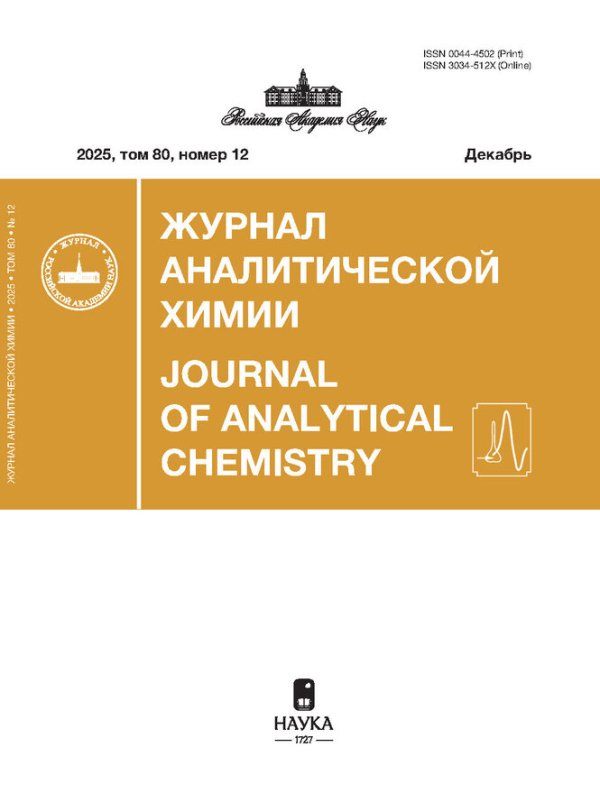Multilayer Coatings Based On Citrate-Stabilized Gold Nanoparticles and Polydiallyldimethylammonium Chloride for the Electrophoretic Separation of Carboxylic Acids
- Authors: Makeeva D.V.1, Antipova K.S.1, Solovyeva E.V.1, Morgacheva V.P.1, Kolobova E.A.1, Kartsova L.A.1
-
Affiliations:
- St. Petersburg State University
- Issue: Vol 78, No 3 (2023)
- Pages: 241-252
- Section: ORIGINAL ARTICLES
- Submitted: 14.10.2023
- URL: https://journals.rcsi.science/0044-4502/article/view/136008
- DOI: https://doi.org/10.31857/S0044450223030088
- EDN: https://elibrary.ru/FUQJKK
- ID: 136008
Cite item
Full Text
Abstract
The conditions for the formation of physically adsorbed three-layer coatings of quartz capillary walls in capillary electrophoresis (CE) with successively deposited oppositely charged layers of polydiallyldimethylammonium chloride (PDADMAC) modifiers and citrate-stabilized gold nanoparticles (GNPs) are proposed. It was shown that three-layer PDADMAC–GNP–PDADMAC coatings favorably differ from monolayer coatings with PDADMAC by greater stability in a wide range of pH (2–10). The formed coatings were characterized by scanning electron microscopy, and the presence of a uniform dense layer of nanoparticles on the capillary surface was confirmed. The applicability of the modified capillaries under CE conditions was demonstrated by the separation of a mixture of 16 carboxylic acids. An increase in the separation selectivity achieved with the use of three-layer coatings based on GNPs was explained by the reversible exchange of citrate anions on the GNP surface with negatively charged analytes in the course of electrophoretic analysis.
About the authors
D. V. Makeeva
St. Petersburg State University
Email: dasha.dzema@gmail.com
199034, St. Petersburg, Russia
K. S. Antipova
St. Petersburg State University
Email: dasha.dzema@gmail.com
199034, St. Petersburg, Russia
E. V. Solovyeva
St. Petersburg State University
Email: dasha.dzema@gmail.com
199034, St. Petersburg, Russia
V. P. Morgacheva
St. Petersburg State University
Email: dasha.dzema@gmail.com
199034, St. Petersburg, Russia
E. A. Kolobova
St. Petersburg State University
Email: dasha.dzema@gmail.com
199034, St. Petersburg, Russia
L. A. Kartsova
St. Petersburg State University
Author for correspondence.
Email: dasha.dzema@gmail.com
199034, St. Petersburg, Russia
References
- Карцова Л.А., Макеева Д.В., Бессонова Е.А. Современное состояние метода капиллярного электрофореза // Журн. аналит. химии. 2020. Т. 12. № 75. С. 1059.
- Kartsova L.A., Makeeva D.V., Davankov V.A. Capillary electrophoresis as a powerful tool for the analyses of bacterial samples // Trends Anal. Chem. 2019. V. 120. Article 115656. https://doi.org/10.1016/j.trac.2019.115656
- Ban E., Yoo Y.S., Song E.J. Analysis and application of nanoparticles in capillary electrophoresis // Talanta. 2015. V. 141. P. 15. https://doi.org/10.1016/j.talanta.2015.03.020
- Zhang Z., Yan B., Liu K., Liao Y., Liu H. CE-MS analysis of heroin and its basic impurities using a charged polymer-protected gold nanoparticle-coated capillary // Electrophoresis. 2009. V. 30. P. 379. https://doi.org/10.1002/elps.200800069
- Hamer M., Yone A., Rezzano I. Gold nanoparticle-coated capillaries for protein and peptide analysis on open-tubular capillary electrochromatography // Electrophoresis. 2021. V. 33. P. 334. https://doi.org/10.1002/elps.201100297
- Kang H., Buchman J.T., Rodriguez R.S., Ring H.L., He J., Bantz K.C., Haynes C.L. Stabilization of silver and gold nanoparticles: preservation and improvement of plasmonic functionalities // Chem. Rev. 2019. V. 119. № 1. P. 664. https://doi.org/10.1021/acs.chemrev.8b00341
- Neiman B., Grushka E., Lev O. Use of gold nanoparticles to enhance capillary electrophoresis // Anal. Chem. 2001. V. 73. P. 5220. https://doi.org/10.1021/ac0104375
- Yu C.J., Su C.L., Tseng W.L. Separation of acidic and basic proteins by nanoparticle-filled capillary electrophoresis // Anal. Chem. 2006. V. 78. P. 8004. https://doi.org/10.1021/ac061059c
- Subramaniam V., Griffith L., Haes A.J. Varying nanoparticle pseudostationary phase plug length during capillary electrophoresis // Analyst. 2011. V. 136. P. 3469. https://doi.org/10.1039/C1AN15185A
- Qu Q., Liu D., Mangelings D., Yang C., Hu X. Permanent gold nanoparticle coatings on polyelectrolyte multilayer modified capillaries for open-tubular capillary electrochromatography // J. Chromatogr. A. 2010. V. 1217. P. 6588. https://doi.org/10.1016/j.chroma.2010.08.057
- Robb C.S. Applications of physically adsorbed polymer coatings in capillary electrophoresis // J. Liq. Chromatogr. Relat. Technol. 2007. V. 30. № 5. P. 729. https://doi.org/10.1080/10826070701191029
- Morrison D.J., Preston T. Formation of short chain fatty acids by the gut microbiota and their impact on human metabolism // Gut Microbes. 2016. V. 7. P. 189. https://doi.org/10.1080/19490976.2015.1134082
- Zhang Q., Niu Y., Lyu W., Yu M. Formic acid up-regulates vascular tension through nitric oxide-cGMP signaling pathway // Chem. Biol. Interact. 2019. V. 309. Article 108710. https://doi.org/10.1016/j.cbi.2019.06.023
- Galland L. The gut microbiome and the brain // J. Med. Food. 2014. V. 17. P. 1261. https://doi.org/10.1089/jmf.2014.7000
- Frens G. Controlled nucleation for the regulation of the particle size in monodisperse gold suspensions // Nat. Phys. Sci. 1973. V. 241. P. 20.
- Polikarpova D., Makeeva D., Kartsova L., Dolgonosov A., Kolotilina N. Nano-sized anion-exchangers as a stationary phase in capillary electrochromatography for separation and on-line concentration of carboxylic acids // Talanta. 2018. V. 188. P. 744. https://doi.org/10.1016/j.talanta.2018.05.094
Supplementary files
















